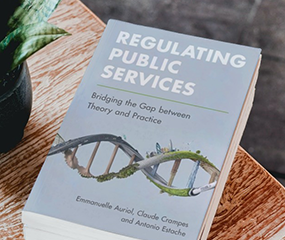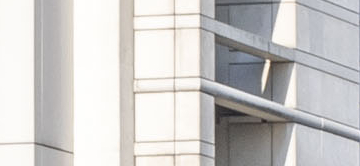 In October, TSE researchers Emmanuelle Auriol and Claude Crampes published a new book entitled ‘Regulating Public Services: Bridging the Gap between Theory and Practice’ (Cambridge University Press). With fellow economist Antonio Estache (Université libre de Bruxelles), the three authors explore the latest theory and policy tools that are urgently needed to tackle the diverse regulatory challenges of the 21st century.
In October, TSE researchers Emmanuelle Auriol and Claude Crampes published a new book entitled ‘Regulating Public Services: Bridging the Gap between Theory and Practice’ (Cambridge University Press). With fellow economist Antonio Estache (Université libre de Bruxelles), the three authors explore the latest theory and policy tools that are urgently needed to tackle the diverse regulatory challenges of the 21st century.
As a member of the TSE Infrastructure and Network Center, Emmanuelle is an expert in regulation, industrial organization and development economics. Claude specializes in the economics of networks, industrial organization and intellectual property, and has worked as an advisor for energy utilities and regulators in Europe. Antonio previously spent 25 years at the World Bank, working on public-sector policies including regulation. They took a quick break from their research to answer some of our questions.
What’s a good theory, as far as regulation is concerned?
In economics at least, a good theory is one that leads to robust and efficient policies that are socially, financially, administratively, and politically sustainable. Theory is essential to ensure that the tools of economic regulation are analytically rigorous and deliver coherent decisions that address jointly the usual efficiency, equity, and financial viability goals. But regulation also must reflect legal and political concerns. Economic theory is therefore only one of the pillars of regulation, necessary, but not sufficient.
How big is the gap between theory and practice in the regulation of public services?
The gap is quite significant, but its size varies across sectors. In the telecoms and to some extent electricity sectors, the gap has become quite modest. In others such as transport and water, the political and social sensitivity of regulatory policy decisions has limited the margin to put many theoretical insights into practice. The gap also varies across countries, as institutional and fiscal capacities differ quite significantly. Moreover, multiple exogeneous factors – such as digitalization, “platformization”, or financial and energy crises – are constantly impacting the business model of public service providers, creating new gaps between theory and practice. These evolving and diversified contexts demand fast and continuous adaptation of regulation: in particular, the design of new analytical tools able to internalize the impact of the changes or the improvements in the understanding of constraints regulators face. The book summarizes the state of the art in theory, but also shows how regulatory practice around the globe has closed the gap in key dimensions.
What can we learn from comparing regulation in different sectors such as electricity, transport and water?
All these sectors are characterized by technologies with increasing returns to scale in key dimensions of their activities, notably due to very high infrastructure costs. Opening them up to competition has required specific rules on access to infrastructure and many of these can be transposed to other industries. More recently, the analysis of two-sided markets initiated to analyze banking networks is directly applicable to the study of platforms such as Amazon, Airbnb, Blablacar and Uber.
How does your book serve as a guide to regulators?
What does not get measured, often does not get done. Any regulatory decision should start with a robust diagnostic of the markets analyzed, the incentives issues that are likely to distort outcomes, and the institutional constraints on the feasibility of regulatory options. The optimal choice of tools has to be influenced by these characteristics. One-size regulation does not fit all contexts.
Since the Laffont-Tirole textbook on procurement and regulation in the early 1990s, there has been a lot of conceptual and empirical research. The objective of our book was to take stock of this new knowledge and produce a rigorous, more operational discussion of the theory and its relevance for the concrete design of regulation. For instance, we have introduced new insights on the nexus between the practice of regulation and finance as well as on the regulatory tools available to jointly address social and efficiency concerns, including when fiscal constraints limit direct subsidies to the poorest.
In legal terms, regulators are supposed to be independent from political authorities and firms. In reality, they are constantly under pressure from both sides, depending on the impact regulation can have on the electoral process or the business cycle, for example, and on the management of economic shocks such as the Russian invasion of Ukraine. It is therefore essential to provide objective qualitative and quantitative tools to enable them to fulfill their mission of putting private interests at the service of the public interest.
What will the future of regulation look like?
It will be more data intensive, more sensitive to fast-evolving technologies and to environmental and social constraints. It will require much more coordination across regulatory, competition and environmental agencies because the borders between mandates will be blurred by overlapping responsibilities. It will also require much greater coordination at the international level, as many companies in the sector are multinationals and many of the challenges of the future, such as global warming, transcend the national scale.
Regulating Public Services
Bridging the Gap between Theory and Practice
Authors: Emmanuelle Auriol (TSE), Claude Crampes (TSE), Antonio Estache, Université Libre de Bruxelles
Publisher: Cambridge University Press
Date published: October 2021
Format: Paperback
ISBN: 9781108987479
Article published in TSE Reflect, May 2022





